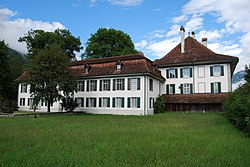Interlaken Monastery
| Kloster Interlaken | |

Interlaken Castle, incorporating parts of the monastery
|
|
| Monastery information | |
|---|---|
| Other names | German: Augustinerchorherrenstift mit angegliedertem Frauenkonvent |
| Order | Augustinians |
| Established | by 1133 |
| Disestablished | 1528 |
| Diocese | Lausanne |
| People | |
| Founder(s) | Baron Seliger of Oberhofen |
| Architecture | |
| Heritage designation | Swiss heritage site of national significance |
| Site | |
| Location | Interlaken |
| Coordinates | 46°41′13″N 7°51′50″E / 46.686949°N 7.8638°ECoordinates: 46°41′13″N 7°51′50″E / 46.686949°N 7.8638°E |
| Visible remains | Part of Interlaken Castle, used for municipal government offices |
Interlaken Monastery (German: Kloster Interlaken or German: Augustinerchorherrenstift) was a convent of the Augustinian Canons Regular (German: Augustinerchorherren) from about 1133 until 1528 at Interlaken in the Canton of Bern in Switzerland. It is a Swiss heritage site of national significance.
The provost of the Monastery was first mentioned in 1133 when Holy Roman Emperor Lothair took the Monastery, founded by Baron Seliger of Oberhofen, under his protection. The Monastery was part of the diocese of Lausanne. According to the deed of 1133, the members of the Monastery were allowed to choose their own provost and kastvogt or bailiff over a religious institution. During the 12th century the provosts were confirmed by the bishop as well as by the pope. By 1247, there were also women at the Monastery. During the 12th century the kastvogt office came to the von Eschenbach family. However, in 1308, Walther von Eschenbach helped John Parricida murder John's uncle king Albert I. In 1318, the family lost their position at Interlaken when Albert's son, Duke Leopold I was elected kastvogt. When he died in 1325, the provost and general chapter transferred the office to his brother Albert II. However, the Monastery remained able to choose their own provost and kastvogt. Starting in the 15th century Bern tried to become the patron of the monastery but did not succeed until 1472.
...
Wikipedia

